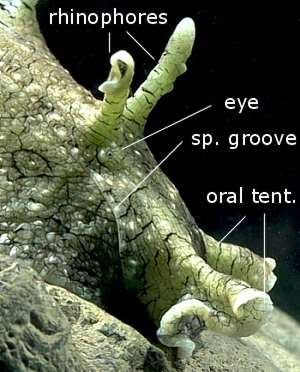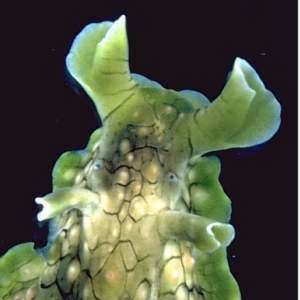

Aplysioidea - head
Order: ANASPIDEA
Superfamily: APLYSIOIDEA
PHOTO
The heads of: Upper: Aplysia dactylomela from the right side, and Lower: Dolabrifera brazieri from above. Photos: Bill Rudman
One distinguishing feature of the Aplysioidea [Sea Hares] is the shape of the head and presence of two pairs of enrolled head tentacles. The front pair [oral tentacles] sit on either side of the mouth. They can be very large and elaborate in some species of Aplysia but in other Sea Hares they can be quite small and simple in shape. In A. dactylomela they are a large and flattened lobe, folded over on itself and wavy along the leading edge. In Dolabrifera brazieri by comparison the oral tentacles are a simple funnel shape. The second pair of tentacles, the rhinophores, sit on the head just behind the eyes. They are also rolled, or have a rolled upper section and a basal stalk. They are considered to be the same organ as the rhinophore in nudibranchs, which has an important chemosensory function, sensing dissolved molecules in the water. The name rhinophore was made up from Ancient Greek words [rhino = nose, phore = carrier] and indicates its role in nudibranchs as a 'nose' providing them with a sense of smell. Studies on Sea Hares suggest that both the rhinophores and the oral tentacles function as organs of smell and touch.
The eyes in opisthobranchs are unable to 'see' objects. They are able to sense light and shade and so are probably useful in sensing the shadows of potential predators and in detecting day and night. Knowing daytime from nighttime is important for animals which want to avoid day light, when they will be obvious to predators. If they are living intertidally, daytime is also a danger period, as the sun's heat at low tide can cause them to dry out.
One other character of the Sea Hares is the presence of their penis in a sac on the right side of their head. To get sperm to the penis from the reproductive opening in the mantle cavity, there is a sperm groove [sp. groove] which runs from just in front of the gill along the body just below the right rhinophore to the opening of the penis sac alongside the right oral tentacle.
Authorship detailsRudman, W.B., 2004 (December 22) Aplysioidea - head. [In] Sea Slug Forum. Australian Museum, Sydney. Available from http://www.seaslugforum.net/factsheet/aplyhead
